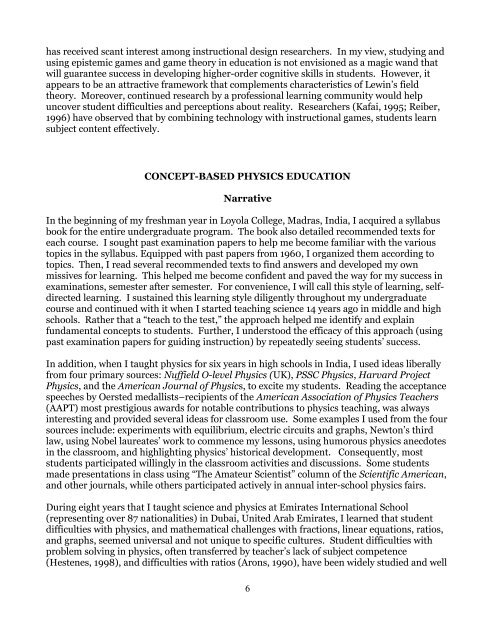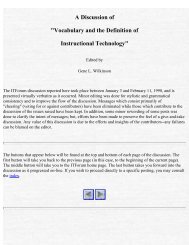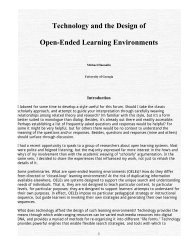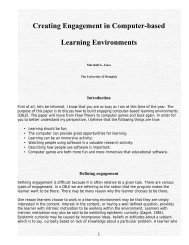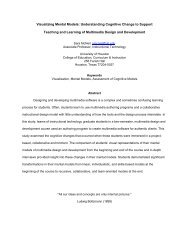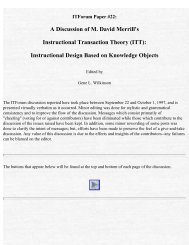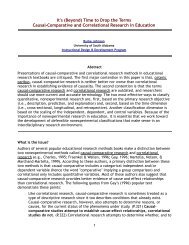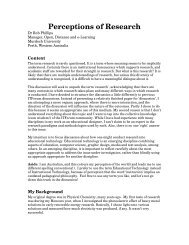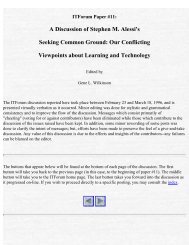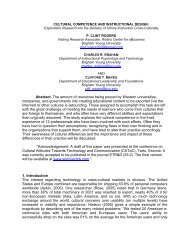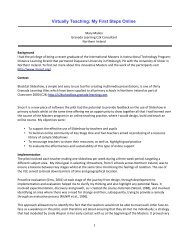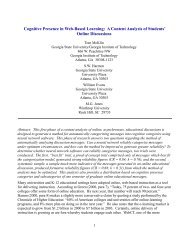SMART EDUCATION: BLENDING SUBJECT EXPERTISE WITH THE CONCEPT OF ...
SMART EDUCATION: BLENDING SUBJECT EXPERTISE WITH THE CONCEPT OF ...
SMART EDUCATION: BLENDING SUBJECT EXPERTISE WITH THE CONCEPT OF ...
You also want an ePaper? Increase the reach of your titles
YUMPU automatically turns print PDFs into web optimized ePapers that Google loves.
has received scant interest among instructional design researchers. In my view, studying and<br />
using epistemic games and game theory in education is not envisioned as a magic wand that<br />
will guarantee success in developing higher-order cognitive skills in students. However, it<br />
appears to be an attractive framework that complements characteristics of Lewin’s field<br />
theory. Moreover, continued research by a professional learning community would help<br />
uncover student difficulties and perceptions about reality. Researchers (Kafai, 1995; Reiber,<br />
1996) have observed that by combining technology with instructional games, students learn<br />
subject content effectively.<br />
<strong>CONCEPT</strong>-BASED PHYSICS <strong>EDUCATION</strong><br />
Narrative<br />
In the beginning of my freshman year in Loyola College, Madras, India, I acquired a syllabus<br />
book for the entire undergraduate program. The book also detailed recommended texts for<br />
each course. I sought past examination papers to help me become familiar with the various<br />
topics in the syllabus. Equipped with past papers from 1960, I organized them according to<br />
topics. Then, I read several recommended texts to find answers and developed my own<br />
missives for learning. This helped me become confident and paved the way for my success in<br />
examinations, semester after semester. For convenience, I will call this style of learning, selfdirected<br />
learning. I sustained this learning style diligently throughout my undergraduate<br />
course and continued with it when I started teaching science 14 years ago in middle and high<br />
schools. Rather that a “teach to the test,” the approach helped me identify and explain<br />
fundamental concepts to students. Further, I understood the efficacy of this approach (using<br />
past examination papers for guiding instruction) by repeatedly seeing students’ success.<br />
In addition, when I taught physics for six years in high schools in India, I used ideas liberally<br />
from four primary sources: Nuffield O-level Physics (UK), PSSC Physics, Harvard Project<br />
Physics, and the American Journal of Physics, to excite my students. Reading the acceptance<br />
speeches by Oersted medallists–recipients of the American Association of Physics Teachers<br />
(AAPT) most prestigious awards for notable contributions to physics teaching, was always<br />
interesting and provided several ideas for classroom use. Some examples I used from the four<br />
sources include: experiments with equilibrium, electric circuits and graphs, Newton’s third<br />
law, using Nobel laureates’ work to commence my lessons, using humorous physics anecdotes<br />
in the classroom, and highlighting physics’ historical development. Consequently, most<br />
students participated willingly in the classroom activities and discussions. Some students<br />
made presentations in class using “The Amateur Scientist” column of the Scientific American,<br />
and other journals, while others participated actively in annual inter-school physics fairs.<br />
During eight years that I taught science and physics at Emirates International School<br />
(representing over 87 nationalities) in Dubai, United Arab Emirates, I learned that student<br />
difficulties with physics, and mathematical challenges with fractions, linear equations, ratios,<br />
and graphs, seemed universal and not unique to specific cultures. Student difficulties with<br />
problem solving in physics, often transferred by teacher’s lack of subject competence<br />
(Hestenes, 1998), and difficulties with ratios (Arons, 1990), have been widely studied and well<br />
6


